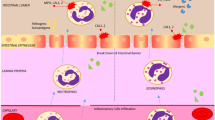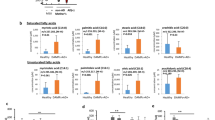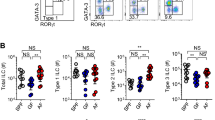Abstract
Long chain polyunsaturates (LCP) status during the early neonatal period is associated with a reduced risk of atopic symptoms and later allergies. In this study, we characterized the immune response of low-risk, term, formula-fed infants randomized at ≤14 d of age to standard term formula (Formula) or formula containing LCP (Formula+LCP) for 4 wks. Infants exclusively fed human milk were included for comparison. Peripheral blood was collected at 14 and 42 d of age, and lymphocyte phenotype, proliferation, and cytokine production (IL-2, IL-4, IL-6, IL-10, IL-12, IFN-γ, TNF-α, TGFβ) were assessed after incubation with β-lactoglobulin (BLG) and soy protein (SOY). Lymphocyte proliferation did not differ between groups. Compared with human milk-fed infants at 2 wks, formula-fed infants produced more TNF-α and IFN-γ and had more cells expressing ICAM-1 (CD54) after incubation with BLG and SOY (p < 0.05). At 6 wks of age, infants fed Formula+LCP produced more TNF-α with SOY (3.2-fold) and IFN-γ (3.3-fold) with BLG compared with infants fed Formula (p < 0.05). In conclusion, low-risk term infants fed formula before 14 d of age produced more TNF-α and IFN-γ in response to food proteins. Feeding Formula+LCP for 4 wks maintained the higher TNF-α and IFN-γ response to these food proteins.
Similar content being viewed by others
Log in or create a free account to read this content
Gain free access to this article, as well as selected content from this journal and more on nature.com
or
Abbreviations
- AA:
-
arachidonic acid
- B:
-
biotin
- BLG:
-
β-lactoglobulin
- DHA:
-
docosahexaenoic acid
- Formula:
-
infants fed standard full term infant formula without long chain polyunsaturated fatty acids
- Formula+LCP:
-
infants fed the formula supplemented with the long chain polyunsaturated fatty acids arachidonic acid and docosahexaenoic acid
- HM:
-
human milk
- LCP:
-
long chain polyunsaturated fatty acids
- PUFA:
-
polyunsaturated fatty acids
- PE:
-
phycoerythrin
- SOY:
-
soy proteins with a significantly reduced isoflavone content
References
Hill DJ, Hosking CS 1995 The cow milk allergy complex: overlapping disease profiles in infancy. Eur J Clin Nutr 49: S1–S12
Abraham CM, Ownby DR 2005 Ontogeny of the allergic inflammatory response. Immunol Allergy Clin North Am 25: 215–229
Hoppu U, Rinne M, Lampi AM, Isolauri E 2005 Breast milk fatty acid composition is associated with development of atopic dermatitis in the infant. J Pediatr Gastroenterol Nutr 41: 335–338
Prescott SL, Calder PC 2004 N-3 polyunsaturated fatty acids and allergic disease. Curr Opin Clin Nutr Metab Care 7: 123–129
Dunstan JA, Mori TA, Barden A, Beilin LJ, Taylor AL, Holt PG, Prescott SL 2003 Fish oil supplementation in pregnancy modifies neonatal allergen-specific immune responses and clinical outcomes in infants at high risk of atopy: a randomized, controlled trial. J Allergy Clin Immunol 112: 1178–1184
Prescott SL 2003 Early origins of allergic disease: a review of processes and influences during early immune development. Curr Opin Allergy Clin Immunol 3: 125–132
Bjorksten B 1999 The intrauterine and postnatal environments. J Allergy Clin Immunol 104: 1119–1127
Vaarala O, Saukkonen T, Savilahti E, Klemola T, Akerblom HK 1995 Development of immune response to cow's milk proteins in infants receiving cow's milk or hydrolyzed formula. J Allergy Clin Immunol 96: 917–923
Wilson CB, Penix L, Weaver WM, Melvin A, Lewis DB 1992 Ontogeny of T lymphocyte function in the neonate. Am J Reprod Immunol 28: 132–135
de Vries E, de Groot R, de Bruin-Versteeg S, Comans-Bitter WM, van Dongen JJ 1999 Analysing the developing lymphocyte system of neonates and infants. Eur J Pediatr 158: 611–617
Holt PG, Jones CA 2000 The development of the immune system during pregnancy and early life. Allergy 55: 688–697
van Odijk J, Kull I, Borres MP, Brandtzaeg P, Edberg U, Hanson LA, Host A, Kuitunen M, Olsen SF, Skerfving S, Sundell J, Wille S 2003 Breastfeeding and allergic disease: a multidisciplinary review of the literature (1966–2001) on the mode of early feeding in infancy and its impact on later atopic manifestations. Allergy 58: 833–843
Host A, Halken S 2005 Primary prevention of food allergy in infants who are at risk. Curr Opin Allergy Clin Immunol 5: 255–259
Calder PC, Miles EA 2000 Fatty acids and atopic disease. Pediatr Allergy Immunol 11: 29–36
Field CJ, Thomson CA, Van Aerde JE, Parrot A, Euler AR, Clandinin MT 2000 The lower proportion of CD45RO+ cells and deficient IL-10 production by formula-fed infants, as compared to human-fed infants, is corrected with supplmentation of long chain-polyunsaturated fatty acids. J Pediatr Gastroenterol Nutr 31: 291–299
Hamill PV, Drizd TA, Johnson CL, Reed RB, Roche AF, Moore WM 1979 Physical growth: national center for health statistics percentiles. Am J Clin Nutr 32: 607–629
Field CJ, Van Aerde JE, Robinson LE, Thomas CM 2008 Effect of providing a formula supplemented with long-chain polyunsaturated fatty acids on immunity in full-term neonates. Br J Nutr 99: 91–99
Wang Z, Goonewardene LA 2004 The use of MIXED models in the analysis of animal experiments with repeated measures data. Can J Anim Sci 84: 1–11
Calder PC 2007 Immunological parameters: what do they mean?. J Nutr 137: 773S–780S
Singh VK, Mehrotra S, Agarwal SS 1999 The paradigm of Th1 and Th2 cytokines: its relevance to autoimmunity and allergy. Immunol Res 20: 147–161
Field CJ 2005 The immunological components of human milk and their effect on immune development in infants. J Nutr 135: 1–4
Jarvinen KM, Laine S, Suomalainen H 2000 Defective tumour necrosis factor-alpha production in mother's milk is related to cow's milk allergy in suckling infants. Clin Exp Allergy 30: 637–643
Macaubas C, Prescott SL, Venaille TJ, Holt BJ, Smallacombe TB, Sly PD, Holt PG 2000 Primary sensitization to inhalant allergens. Pediatr Allergy Immunol 11: 9–11
Strobel S, Mowat AM 2006 Oral tolerance and allergic responses to food proteins. Curr Opin Allergy Clin Immunol 6: 207–213
Suomalainen H, Soppi E, Laine S, Isolauri E 1993 Immunologic disturbances in cow's milk allergy, 2: evidence for defective interferon-gamma generation. Pediatr Allergy Immunol 4: 203–207
Osterlund P, Jarvinen KM, Laine S, Suomalainen H 1999 Defective tumor necrosis factor-alpha production in infants with cow's milk allergy. Pediatr Allergy Immunol 10: 186–190
Sutas Y, Hurme M, Isolauri E 1997 Oral cow milk challenge abolishes antigen-specific interferon-gamma production in the peripheral blood of children with atopic dermatitis and cow milk allergy. Clin Exp Allergy 27: 277–283
Jung T, Moessner R, Dieckhoff K, Heidrich S, Neumann C 1999 Mechanisms of deficient interferon-gamma production in atopic diseases. Clin Exp Allergy 29: 912–919
Paronen J, Vaarala O, Savilahti E, Saukkonen T, Akerblom HK 1996 Soluble adhesion molecules and oral antigen feeding in infants. Pediatr Res 40: 276–279
Mihrshahi S, Peat JK, Webb K, Oddy W, Marks GB, Mellis CM 2004 Effect of omega-3 fatty acid concentrations in plasma on symptoms of asthma at 18 months of age. Pediatr Allergy Immunol 15: 517–522
Prescott SL, Irvine J, Dunstan JA, Hii C, Ferrante A 2007 Protein kinase Czeta: a novel protective neonatal T cell marker that can be upregulated by allergy prevention strategies. J Allergy Clin Immunol 120: 200–206
Romagnani S 2000 The role of lymphocytes in allergic disease. J Allergy Clin Immunol 105: 399–408
Liao SY, Liao TN, Chiang BL, Huang MS, Chen CC, Chou CC, Hsieh KH 1996 Decreased production of IFN gamma and increased production of IL-6 by cord blood mononuclear cells of newborns with a high risk of allergy. Clin Exp Allergy 26: 397–405
Acknowledgements
The authors thank Susan Goruk for outstanding technical assistance and Bodil Larsen for her excellent skills in coordinating the clinical aspects of this study. The authors thank the significant help of Kathryn Pramuk of the Medical Affairs Department of Wyeth Nutrition in the design and execution of this study.
Author information
Authors and Affiliations
Corresponding author
Additional information
Supported by funding from Wyeth Nutritionals International and MTI Meta Tech Inc.
Rights and permissions
About this article
Cite this article
Field, C., Van Aerde, J., Robinson, L. et al. Feeding a Formula Supplemented With Long Chain Polyunsaturated Fatty Acids Modifies the “Ex Vivo” Cytokine Responses to Food Proteins in Infants at Low Risk for Allergy. Pediatr Res 64, 411–417 (2008). https://doi.org/10.1203/PDR.0b013e318181b391
Received:
Accepted:
Issue date:
DOI: https://doi.org/10.1203/PDR.0b013e318181b391



